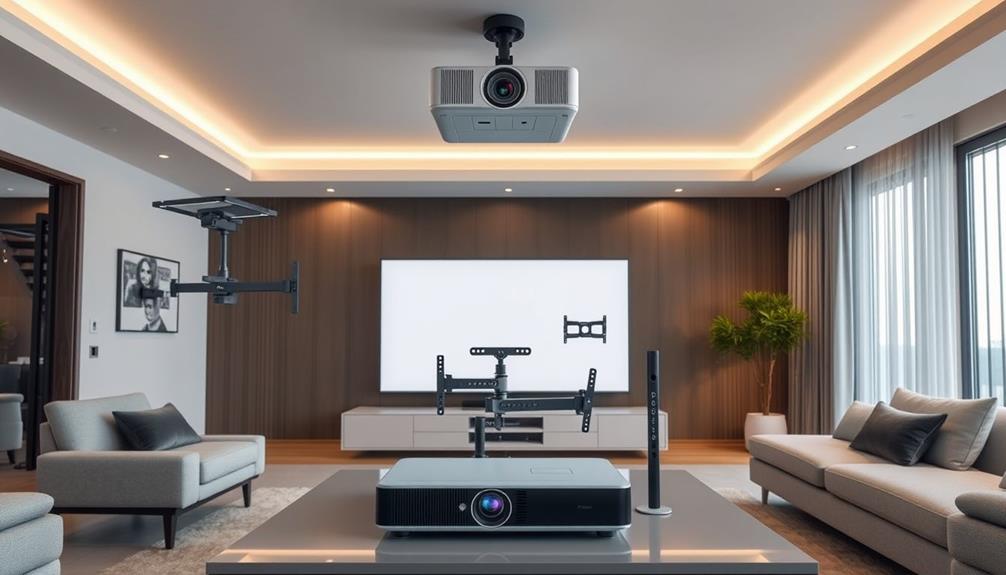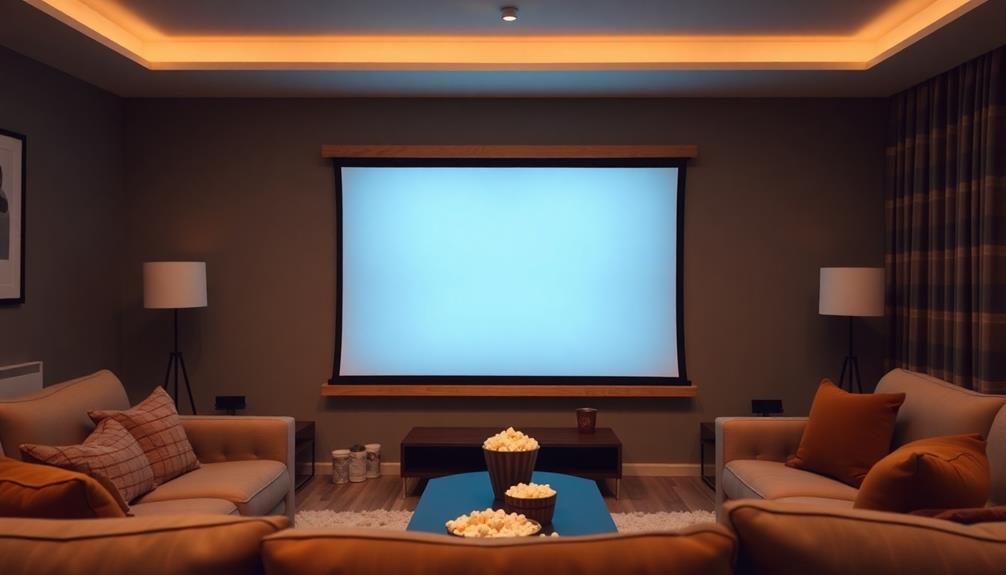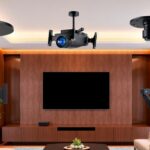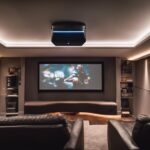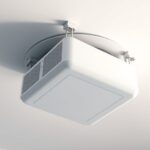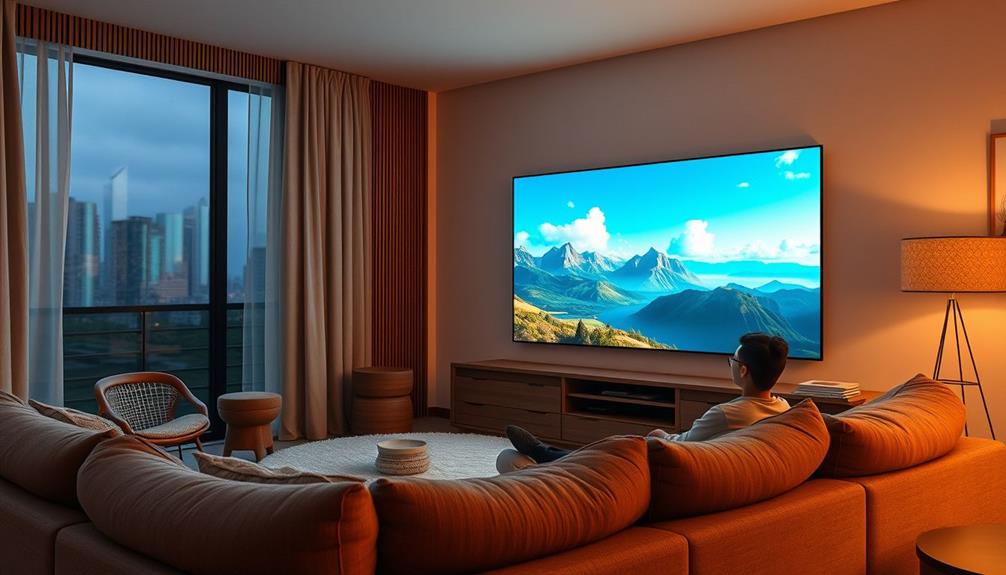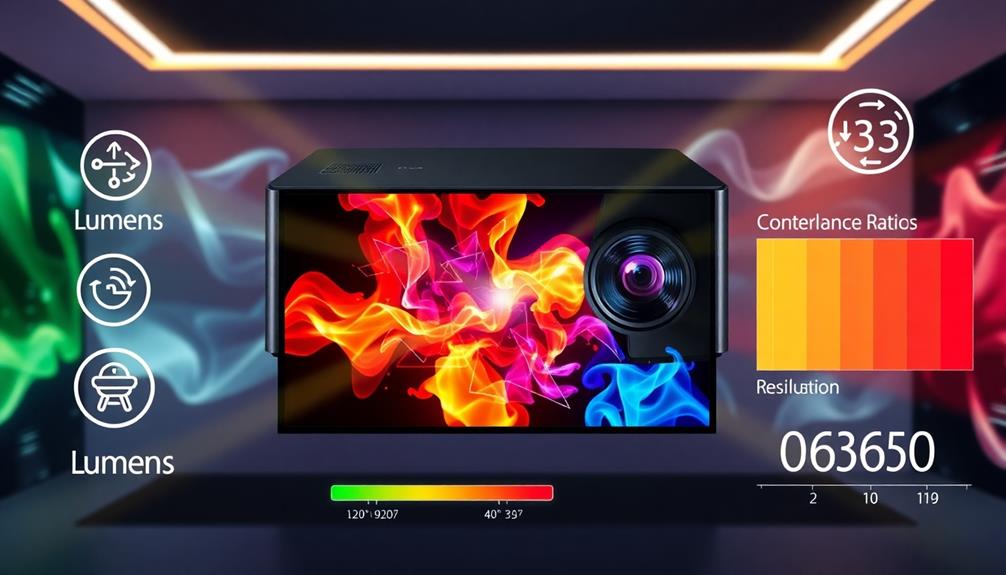Choosing the right projector mount starts with evaluating your room layout and projector specifications. Consider if you need a ceiling, wall, shelf, or stand mount based on your space and aesthetic preferences. Be certain to check weight capacity and ventilation needs to avoid overheating. Compatibility with your projector is key, so consult specs for a precise fit. Think about future upgrades, too, as this can impact your choice. By understanding these factors, you'll guarantee an ideal viewing experience. Discover more tips to refine your selection process and enhance your entire setup.
Key Takeaways
- Assess your room layout and size to determine the ideal mounting position for optimal projection quality.
- Consider the projector's weight and ensure the mount's weight capacity is sufficient for stability and safety.
- Evaluate compatibility with your projector model to prevent installation issues and ensure proper function.
- Think about ambient light conditions when selecting a mount to minimize glare and enhance image clarity.
- Explore different mount types (ceiling, wall, shelf, stands) to find the one that best fits your aesthetic and functional needs.
Importance of Proper Mounting
Understanding the importance of proper mounting can greatly enhance your viewing experience. When you install your projector safely on a ceiling or wall, you guarantee top-notch image quality.
A well-mounted projector provides sharp, clear, and aligned projections, making your presentations or movie nights much more enjoyable. Additionally, a good mounting solution can contribute to better sound performance, especially when integrated with a home theater setup that includes quality audio systems.
Safety is another critical aspect of mounting. By securing your projector correctly, you prevent potential falls and injuries, offering peace of mind, especially in high-traffic areas. Additionally, effective mounting solutions save valuable floor space, creating a more organized and clutter-free environment.
Proper installation allows for angle adjustments, which can markedly improve image stability and reduce the risk of overheating or damage to the equipment.
Types of Projector Mounts

When selecting a projector mount, you'll find several types available, each catering to different needs and environments.
Shelf mounts are cost-effective options that offer a sturdy flat surface attached to the wall. While they're easy to install, guarantee careful construction to avoid collapse; they mightn't blend well with all home decor.
For those looking to elevate their space with some creativity, consider how a projector can complement your living room transformation goals.
Ceiling mounts provide a fixed position, ideal for permanent installations, guaranteeing safety and balance for your projector. However, they complicate maintenance and angle adjustments due to their height.
Wall mounts integrate well with room decor and can support heavyweight projectors, but they limit your viewing angle flexibility.
If you prefer mobility, consider projector stands. These versatile devices are suitable for various setups, including outdoor use, allowing easy relocation and adjustments.
For a more elegant solution, projector lifts conceal the projector when it's not in use, enhancing your room's aesthetics while saving space. However, be prepared for additional installation considerations.
Advantages and Disadvantages

When choosing a projector mount, you need to weigh the advantages and disadvantages of each option.
Consider factors like stability, aesthetics, and flexibility to find the best fit for your space.
Additionally, understanding how design principles can enhance your overall setup can be beneficial, especially when you think about fostering a culture of creativity and experimentation in your workspace Design Thinking Leadership.
Understanding these key points will help you make a more informed decision.
Mounting Options Overview
There are several mounting options for projectors, each with its own set of advantages and disadvantages. Shelf mounts are a cost-effective choice, providing a solid base for your projector. However, they can pose safety risks if not constructed properly and might clash with your home decor aesthetics.
Additionally, considering the investment in a Gold IRA can hedge against inflation, similar to how projector mounts protect your technology.
Ceiling mounts offer great stability and safety, making them ideal for permanent setups, but they can be difficult to adjust for best viewing angles and require ladders for maintenance.
Wall mounts integrate well with your decor and can support heavier projectors, yet they limit flexibility in viewing angles and may not suit all room layouts.
If mobility is essential for your setup, projector stands provide versatility, allowing for different configurations, including outdoor use. However, they may lack stability compared to fixed mounts in certain environments.
Lastly, projector lifts enhance aesthetics by concealing the projector when it's not in use, but they can be more expensive and complex to install than traditional options.
Key Considerations for Selection
Choosing the right projector mount involves several key considerations that can greatly impact your viewing experience.
First, evaluate your room layout and size, as ceiling height and available wall space will affect your mounting options. For instance, ceiling mounts offer safety and a clean look but can complicate maintenance, while shelf mounts are cost-effective but might clash with your decor. Additionally, conducting thorough keyword research can help identify the best options for your specific needs.
Next, consider your projection requirements, including screen size and aspect ratio. The necessary distance and viewing angle for effective projection are vital for ideal results. Make sure to assess compatibility with your specific projector models; dedicated mounts align screw holes perfectly, while universal mounts offer flexibility across various devices.
Don't forget to factor in ambient light conditions, as they can greatly influence image clarity. The right mount should help minimize glare and enhance viewing quality.
Key Factors for Selection

Evaluating your needs is crucial when selecting a projector mount. Start by evaluating your room layout and size, taking into account wall space availability and ceiling height. This helps you determine the most suitable mounting position for ideal projector placement.
Next, understand your projection requirements by defining the desired image size, aspect ratio, and the distance necessary for effective image projection. Incorporating various aspects of your setup, such as the potential for future upgrades or changes, can further enhance your choice. It's also beneficial to contemplate the ideal investment strategy for your equipment, guaranteeing you're getting the best value for your needs.
Review viewing angles and distance to guarantee that your mount allows for ideal image alignment, while also accommodating ambient light conditions that could affect image clarity. It's crucial to take into account throw distance and mount shift capabilities, as these factors guarantee proper projector setup and help achieve the desired image size and quality.
Lastly, consult with experts or refer to manufacturer specifications for tailored recommendations on projector mounts that support various projector types and weights. By focusing on these key factors, you'll be better equipped to choose a mount that perfectly fits your setup, enhances your viewing experience, and meets your unique needs.
Specific Mounts Overview

When you're choosing a projector mount, understanding the different types available is essential. Each mount comes with its own key features and installation factors that can impact your setup.
It's important to take into account aspects such as weight capacity and compatibility with your projector model, as improper mounting can lead to performance issues.
Additionally, ensuring that your mount is placed in a suitable environment is critical for ideal projector function, much like how cat health and nutrition can influence a pet's wellbeing.
Let's compare the options to help you find the best fit for your needs.
Mount Types Comparison
A variety of projector mounts cater to different needs and preferences, influencing both functionality and aesthetics in your space.
When considering a mount types comparison, here are some common options:
1. Ceiling Mounts: These guarantee safety and balance, making them ideal for permanent setups. They're often recommended for larger spaces where ceiling height allows for peak projection.
However, they can be tricky to adjust and require ladders for maintenance.
2. Wall Mounts: These integrate well with your home decor and can support heavier projectors.
Consider the importance of reputation and reviews from past clients when choosing a service to install your mount.
But keep in mind that they offer limited viewing angle flexibility.
3. Shelf Mounts: Cost-effective and providing a solid base, shelf mounts can clash with home decor if not chosen carefully.
They may also pose safety risks if not properly constructed.
For more versatility, consider projector stands that allow for easy relocation, or projector lifts that conceal the projector when not in use, enhancing your room's aesthetics.
Each option has its pros and cons, so assess your space and usage needs carefully to guarantee you choose the best mount for your setup.
Key Features Evaluation
Choosing the right projector mount involves understanding the unique features that each option brings to the table. If you're looking for versatility, the XGIMI Portable Stand is a great choice, offering 360° panoramic rotation and height adjustment up to 795mm. This makes it suitable for both desktop and floor use.
Additionally, using a projector can enhance your home entertainment experience, similar to how ceiling fans enhance air circulation for overall comfort. The XGIMI X-Desktop Stand Pro combines stability with aesthetics, thanks to its aluminum alloy base and universal compatibility with a ¼-inch screw, while allowing a height adjustment of up to 9.5 cm.
For those needing a more robust option, the XGIMI X-Floor Stand supports a height range from 19 to 35 inches, featuring a triangular base design for enhanced stability in various settings.
If you're considering shelf mounts, they can be a cost-effective solution for wall attachment but may clash with your home decor, especially if not designed for heavy projectors. On the other hand, ceiling mounts provide a clean, fixed integration into your space, though they require ladder access for adjustments or maintenance.
Ultimately, evaluate each mount's stability, viewing angle, and compatibility with your projector and screen.
Installation Considerations
Selecting the right installation method for your projector can make all the difference in achieving the best viewing experience. Here are some key options to take into account:
- Ceiling Mount: Ideal for permanent setups in larger rooms, ceiling mounts provide safety and balance for your projector. They guarantee proper ventilation and can often support heavier models, similar to how garage door openers enhance home security with modern technology.
- Wall Mount: If you're looking for a solution that integrates seamlessly with your home decor, wall mounts are a great choice. They typically support heavier projectors and can easily fit into various aesthetic styles.
- Mobile Options: For maximum versatility, think about mobile projector stands. These allow for easy relocation and adjustments, perfect for both indoor and outdoor use.
When choosing a mount, confirm it's compatible with your projector model. Dedicated mounts are tailored for specific models, while universal mounts offer flexibility.
Also, pay attention to weight capacity and ventilation; mounts must support the projector's weight securely and allow unobstructed airflow to prevent overheating.
XGIMI Mount Options
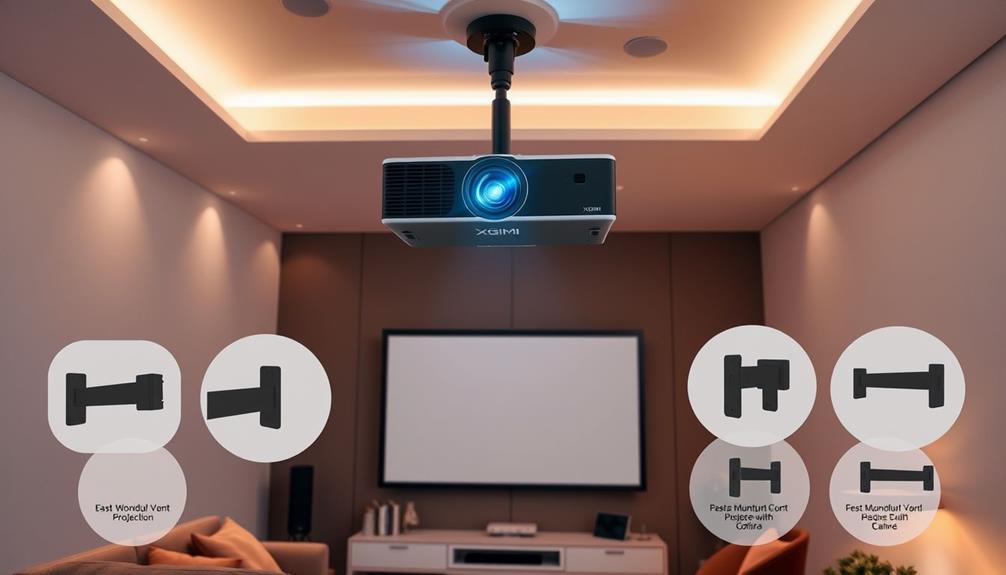
XGIMI's mount options provide the perfect blend of versatility and stability for your projector needs. Whether you're setting up for a home theater or a professional presentation, these XGIMI projector stands offer reliable mounting solutions.
| Mount Type | Key Features | Ideal Use |
|---|---|---|
| XGIMI Portable Stand | 360° panoramic rotation, 5kg load capacity | Mobile setups |
| XGIMI X-Desktop Stand Pro | Universal compatibility, height adjustment (up to 9.5 cm) | optimal image projection |
| XGIMI X-Floor Stand | Adjustable heights (19 to 35 inches) | Indoor and outdoor environments |
All XGIMI stands emphasize stability and ease of use, ensuring that you can focus on your presentation without worry. With sleek aesthetics, these mounting options blend seamlessly into any setting. Plus, they're compatible with a variety of projector models, giving you the flexibility you need for different user needs and environments. Choose XGIMI for a reliable and stylish solution that elevates your viewing experience.
Screen Compatibility

How do you guarantee a seamless viewing experience with your projector? Screen compatibility is key. You need to take into account several factors to assure everything aligns perfectly for ideal image clarity and enjoyment.
- Aspect Ratio: Make sure the projector's aspect ratio matches the screen. This prevents image distortion during presentations or movie nights.
- Throw Distance: Different projectors require specific throw distances to project the right image size. Know your projector's needs to avoid any hiccups.
- Mounting Height: The screen's mounting height should align with your projector installation. An improper height can affect the viewing angle and overall experience.
Larger screens often need secure anchoring, while smaller ones may mount directly to the wall.
Additionally, using brackets for adjustment allows you to fine-tune the distance from the wall, assuring ideal visibility.
Taking these considerations into account helps you achieve a setup that not only looks great but performs well too.
With the right screen compatibility, you can elevate your viewing experience, making every presentation or movie night enjoyable and hassle-free.
Installation Considerations
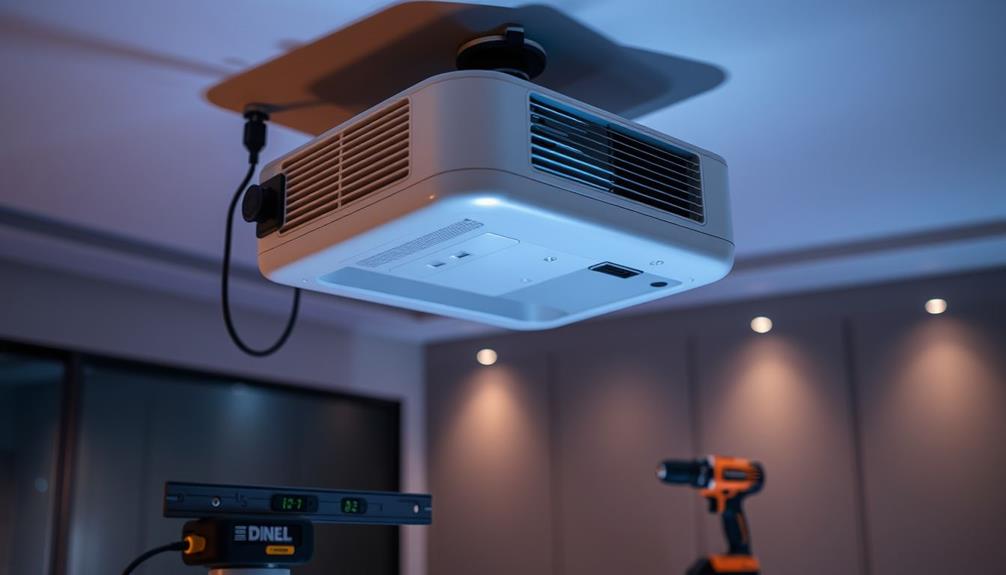
With screen compatibility sorted, it's time to focus on installation considerations that will guarantee your projector setup performs at its best.
Start by evaluating your room layout and size to determine the ideal mounting position. Verify there's enough wall or ceiling space for installation, taking into account the projector model you're using, as different types may require specific configurations for proper alignment and stability.
Next, examine the mounting hardware. Confirm it's rated for the weight of your projector to avoid potential safety hazards or equipment damage.
Pay attention to ventilation requirements, as your mount shouldn't obstruct the projector's cooling fans or airflow; overheating can lead to performance issues.
If you're opting for ceiling mounts, plan for easy access to the projector for maintenance and adjustments. You'll want it to be accessible, especially if you need to use a ladder for retrieval.
Additional Accessories and Products
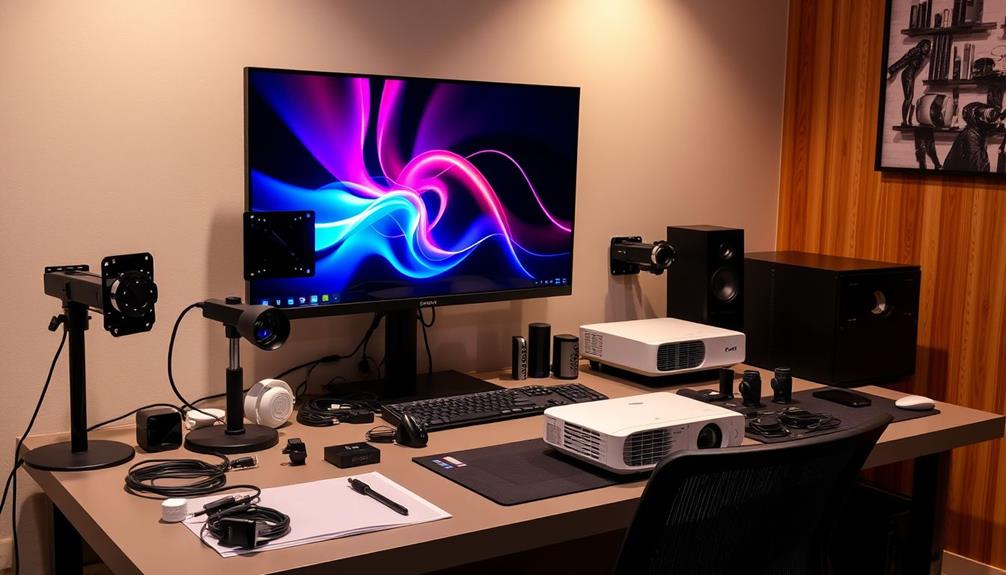
When setting up your projector, considering additional accessories can greatly enhance your overall experience.
These accessories not only improve the functionality of your setup but also boost your projector's performance. Here are three must-have accessories:
- Projector Screens: Investing in a quality projector screen guarantees ideal viewing angles and clarity, making your presentations or movie nights far more enjoyable.
- TV Stick 4K: Priced at €79.99, this device considerably enhances your streaming capabilities, allowing you to access a wider range of content seamlessly.
- Support Multi-Angle Accessories: At €89.99, these versatile accessories provide multiple viewing angles, making sure that everyone in the room has a great view.
Additionally, don't forget about quality cables and adapters for ideal connectivity, which are essential for maintaining clear visuals and sound.
You can often find promotions or bundled purchases through community memberships that save you money on these vital accessories.
Conclusion
Choosing the right projector mount can really enhance your viewing experience. Did you know that 70% of home theater enthusiasts say a proper mount improves picture quality? By considering factors like compatibility, installation ease, and specific features, you can find a mount that suits your setup perfectly. Whether you opt for a fixed or adjustable mount, taking the time to select the right one will elevate your home entertainment to a whole new level!
